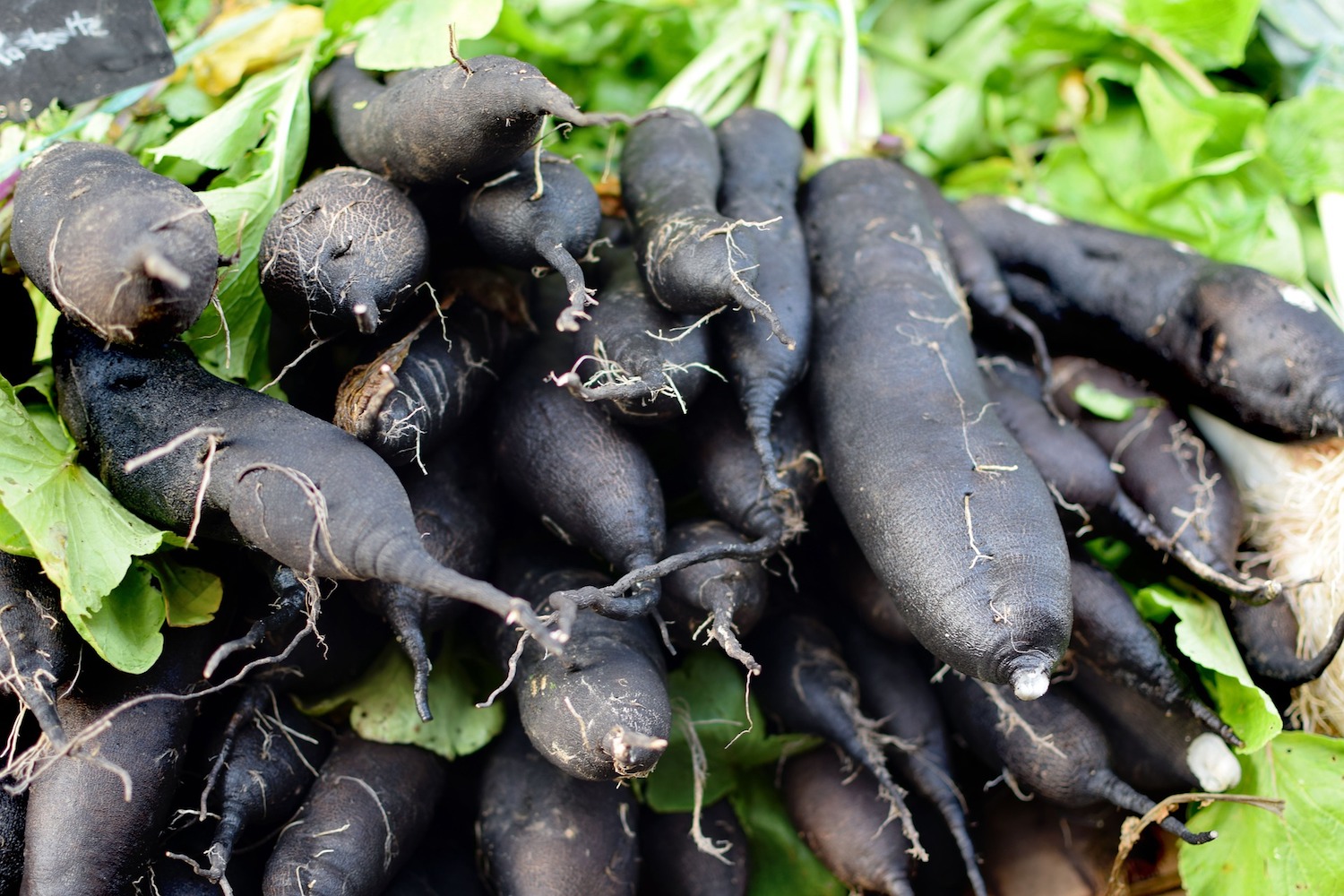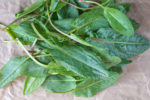
How to Cook Salsify (Oyster Plant)
Salsify (oyster plant) was a popular vegetable in the 1800s, but people didn’t seem to use it much in the 1900s. Salsify is supposed to taste slightly like an oyster, but some people say it tastes more like an artichoke.
You use the roots of salsify just like parsnips or carrots. Peel or scrape the outside and then you can boil, bake, or fry it. Many people add it to soups and stews.
There’s also a similar plant called Scorzonera or Black Salsify (see image). Black Salsify has wider leaves and the root’s skin is black, but it can be grown, harvested, and cooked the same way.
INFORMATION BELOW FROM 1800s COOKBOOKS
SALSIFY consists of long slender roots that are covered with tiny roots. It is somewhat difficult to clean and prepare, but it may be stored through the entire winter. It should not be used until after heavy frosts and is at its best in the spring after being in the ground all winter. Whatever is dug more than is to be used each time, should be kept in sand in a cool place.
In preparing salsify for cooking, scrape the roots rather than peel them. Then put them in a solution of cold salt water made by using one teaspoonful of salt to each quart of water and keep them there until ready to cook them. Or you can put them in water with a little vinegar. These precautions will to a certain extent prevent the discoloration that always takes place in salsify as soon as the skin is removed.
If the plant is first put into cold water to boil and the skin removed, the delicate flavor of the oyster—which constitutes its chief merit—will be entirely dissipated and lost. If there should be dark spots through the oyster plant, be sure that every particle is removed, as one little piece with a dark spot in it will flavor the whole dish.
Cook until tender only, not soft. The flavor of the oyster plant is in the water, so there should always be some liquid left to form part of the sauce. A little cream is required to develop the flavor of oyster plant. Water and cream are better than milk. Milk and a little butter may be used when cream is not obtainable.
BUTTERED SALSIFY
The simplest way to cook salsify is to cut it in thin slices, boil it until tender, and then serve it with butter. Wash and scrape the desired quantity of salsify and slice in thin slices. Put to cook in boiling salted water, and cook until it can be easily pierced with a fork. Drain off the water, season with pepper and if necessary, additional salt, and add one tablespoon of butter for each four persons to be served. Allow the butter to melt and serve the salsify hot.
BOILED SALSIFY
Scrape off the outer skin of the roots, cut in small pieces and throw into water with a little vinegar to prevent it turning brown. Boil at least an hour, as they should be quite soft to be good. When done, put in a little salt codfish picked very fine. Season with butter, salt, and cream, thickened with a little flour or cornstarch, and serve with bits of toast. The fish helps to give it a sea-flavor. Instead of fish, the juice of half a lemon may be used or it is good without any added flavor.
ESCALLOPED SALSIFY
Wash, scrape, cut in thin slices to make three cups. Put into plenty of cold water with a little vinegar till ready to use to prevent discoloration. When ready to cook, drain, and boil in enough water to prevent scorching. Salt when they begin to get tender. Boil a few minutes longer, but do not let them get too salty. Drain, or remove with a skimmer, putting a layer in a baking-pan, then a little rich cream sauce, then another layer of each. Sprinkle the top with sifted bread crumbs, and bake a light brown.
SALSIFY FRITTERS
Scrape some oyster plant and drop quickly into cold water with a few drops of vinegar to prevent its turning dark. Boil until soft in salted water, mash fine, and for every half pint of the pulp add one well beaten egg, a teaspoon of melted butter, a tablespoon of cream, a heaping tablespoon of flour, salt and pepper. Drop into boiling lard or drippings and fry brown. Or, instead of mashing the salsify after boiling, some prefer to drain it, and to dip each piece in batter and fry it in hot lard. Season with salt and pepper after frying, drain in a napkin and serve hot.
FRIED SALSIFY
Scrape, cut into finger lengths and boil in salted water. Drain and cover with a dressing of oil and vinegar, salt and pepper. Let stand until well seasoned, then drain again, sprinkle with parsley and fry in hot fat. Put in but few pieces at a time as each needs attention. Dry in a hot colander and serve.
FRIED SALSIFY No. 2
Stew the salsify as usual till very tender, then with the back of a spoon or a potato jammer, mash it very fine. Beat up an egg, add a teacup* of milk, a little flour, butter, pepper and salt. Make into little cakes, and fry a light brown in boiling lard.
*teacup – same as a jill or gill; four ounces U.S.
MOCK OYSTER SOUP
Select about one dozen roots of salsify. Scrape them and throw at once into cold water to prevent discoloration. Cut the salsify crosswise into thin slices. Put them into one quart of cold water and add about two ounces of codfish. This is best in one solid piece. Simmer gently for thirty minutes and remove the codfish. Have ready one pint of milk heated in a double boiler. Add it to the salsify, then stir in carefully one tablespoon of butter and two of flour that have been rubbed to a smooth paste. Season with salt and pepper. Then, just as you take it from the fire, add another teaspoon of butter, cut into pieces, and it is ready to serve.
CREAMED OYSTER PLANT
Cut scraped roots into slices about one-third inch and drop into the water in which they are to be cooked. Boil without salt and when nearly tender, add salt.To the oyster plant liquor, add a little heavy cream, and when boiling, add flour blended with water to make of a creamy consistency; salt if necessary. Chopped parsley may sometimes be added, and a little celery salt occasionally, but oyster plant will not admit of the addition of many flavors. If to be served on toast or rice, or in a rice border, a little onion juice may be added.
SALSIFY A LA POULETTE
Choose about twenty young ones, scrape the skin, cut them into pieces three inches long, rub each piece with lemon and throw them into water. Then put two onions, a carrot, a turnip, and a head of celery, all cut small into a stewpan, with a handful of parsley, one-fourth pound lean ham, a little thyme, two bay-leaves, and one-fourth pound beef suet chopped fine.
Stir it over a sharp fire ten minutes, then add two ounces of flour (stir well). Fill up with two quarts of water, and add the juice of a lemon. Stir till it boils, then put in your salsify and stew gently till tender. Take them out and lay them upon a cloth to drain.
Then put a pint of white sauce into another stewpan, with half a pint of white stock. Stir over a sharp fire till boiling, then add twenty button mushrooms. Add one teaspoon chopped parsley, season with pepper, salt, grated nutmeg, and powdered sugar.
Put in the salsify, let simmer gently for half an hour or until the sauce is rather thick. Take out, and finish the sauce with a liaison of two yolks of eggs mixed with a gill* of cream. Stir over the fire till it thickens but do not let it boil. Pour the sauce over and serve.
*gill – a liquid measurement; four ounces in the U.S. and five ounces in the U.K.
=================================================
Have You Ever Heard of Salsify? Please Leave a Comment Below.
=================================================
Todd’s Seeds Mammoth Sandwich Island Salsify Heirloom Seed – 5g
High Germination Rate – Results on Every Package – Tested for Pathogens. Untreated, Non-GMO, Pesticide Free Heirloom Seeds
Todd’s Seeds – all hand packaged, family business
=================================================





16 thoughts on “How to Cook Salsify (Oyster Plant)”
My late father planted salsify when I was a kid and my mother made oyster stew out of it. This year I planted it and had a beautiful crop. Haven’t tried the stew yet but I love it sautéed with butter and garlic. I gave several bunches to many local widows and they were so excited to have it once again. No one seems to grow salsify anymore but I will continue to do so each year.
How interesting! I asked my mother if she had heard of it (she’s 91 years old) and she had. She was a young girl then and never grew it herself. I’d love to try it.
My neighbor is 106 and she told us she would love to have some salsify. Her mother would make scalloped salsify so we ordered the seed and planted them and we just harvested some. I’m getting ready to fix it for her today. I just hope it’s good.
What a kind thing to do for your neighbor. I’m sure you’ll be successful in cooking it and she’ll have a fond memory, plus a great meal. Thanks for writing.
My neighbors….all country folk, were talking about salsify one day and how their mother made it with some butter and milk and it tasted like oyster stew. I was intrigued as I had never heard of it before and since I grow a lot of our own vegetables I decided to plant some this year. The seeds germinated very quickly and I have been watching them grow all summer. I just dug up one of the roots today ( October ) and am looking forward to trying some of these recipes !
How exciting! I asked my mother if she ever had it and she had (she’s 89 years old), but I’ve never seen it for sale anywhere. If I ever see it, I’ll try it, too.
Salsify soup, YUM!!!!
I had forgotten some of growing information. I just planted some, I can’t wait for late fall. Child memories about to be retold. Now if I can just remember my Momma’s recipe.
I have never eaten salsify, but my mother remembers having it as a child (she’s 89 years old).
I just saw a recipe in Anne Bradley’s Menu Cookbook I am reading circa 1927. So glad you all could clarify this for me! There is a plant now called “oyster plant” and it is highly toxic. It is NOT salsify. I wish my grandmother were here with me!
Do you have a photo of this plant? In all the old cookbooks I’ve read through (from the U.S. and U.K), salsify was also called oyster plant and people ate it. I’ll check out Anne Bradley’s Menu Cookbook. Even though it’s a bit later than the 1800s, I’m sure it’s quite interesting.
I have heard of this but never knew what it was. No idea why, but I always pictured it as something leafy. I would try them, too, if they taste like artichokes!
I never heard of salsify, but my mother said they ate it when she was a young girl.
I have never heard of these, very interesting!
I had never heard of them, either, until I began reading old cookbooks. I asked my mother if she had (she’s 88 years old) and her mother used to cook them when she was a child.
I’ve heard of this root vegetable (I don’t live in a vacuum), but I’ve never heard of anyone eating it, though I knew it could be eaten. Very cool.
I would love to try them (I like trying new foods). My mother said her mother cooked them when she was a young girl in the late 1930s.